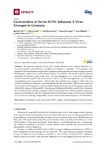2020-07-15Zeitschriftenartikel
Cocirculation of Swine H1N1 Influenza A Virus Lineages in Germany
Zell, Roland
Groth, Marco
Krumbholz, Andi
Lange, Jeannette
Philipps, Anja
Dürrwald, Ralf
The genome analysis of 328 H1N1 swine influenza virus isolates collected in a 13-year long-term swine influenza surveillance in Germany is reported. Viral genomes were sequenced with the Illumina next-generation sequencing technique and conventional Sanger methods. Phylogenetic analyses were conducted with Bayesian tree inference. The results indicate continued prevalence of Eurasian avian swine H1N1 but also emergence of a novel H1N1 reassortant, named Schneiderkrug/2013-like swine H1N1, with human-like hemagglutinin and avian-like neuraminidase and internal genes. Additionally, the evolution of an antigenic drift variant of A (H1N1) pdm09 was observed, named Wachtum/2014-like swine H1N1. Both variants were first isolated in northwest Germany, spread to neighboring German states and reached greater proportions of the H1N1 isolates of 2014 and 2015. The upsurge of Wachtum/2014-like swine H1N1 is of interest as this is the first documented persistent swine-to-swine spread of A (H1N1) pdm09 in Germany associated with antigenic variation. Present enzootic swine influenza viruses in Germany now include two or more co-circulating, antigenically variant viruses of each of the subtypes, H1N1 and H1N2.
Dateien zu dieser Publikation

